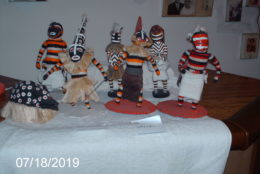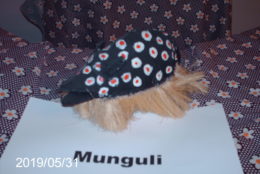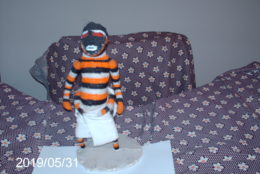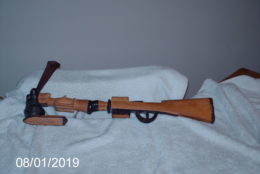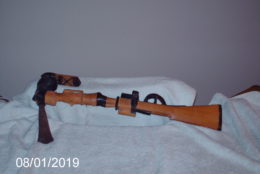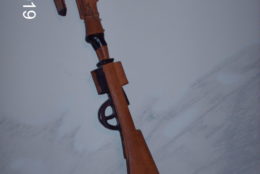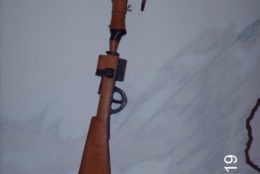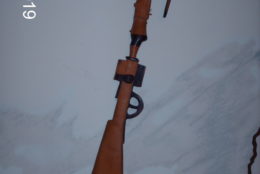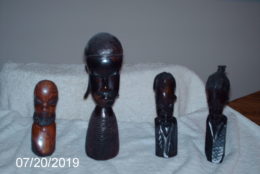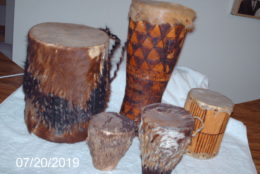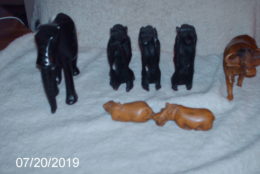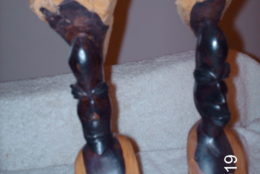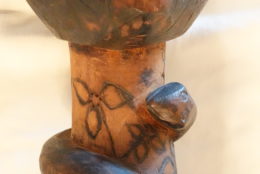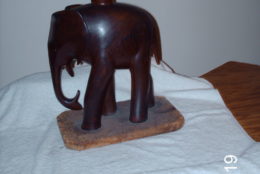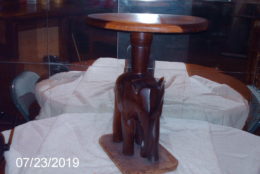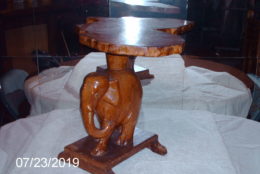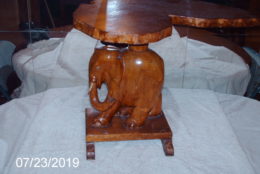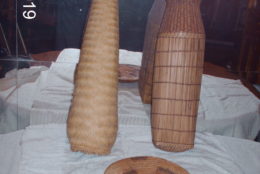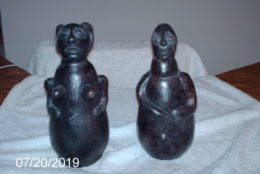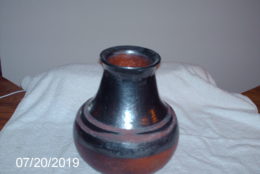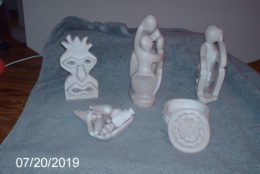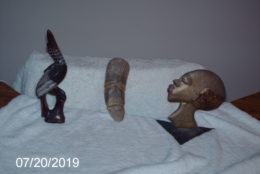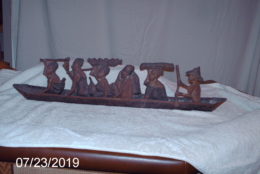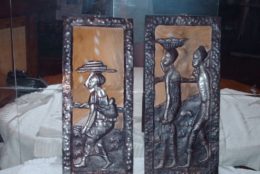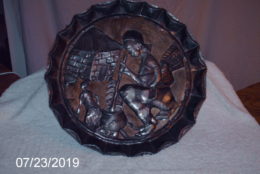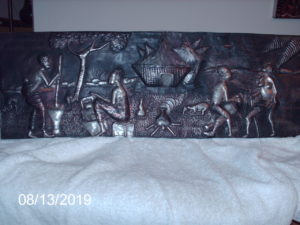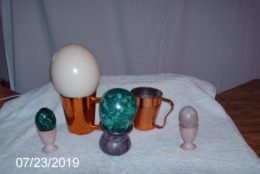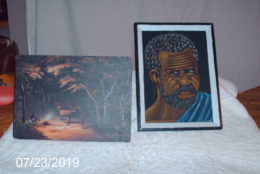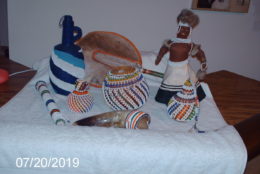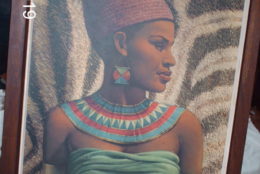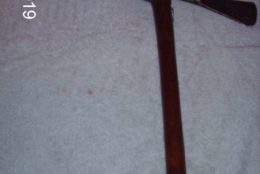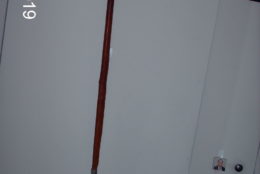This page was created in mid-2019 to display my African art collection (over 100 pieces). Most were collected in Zambezi District between 1963-1968, with a lesser number acquired later between 1971-1979. The photos present a simple classification. I also briefly describe the pieces and note their provenance. I have recently been advised that the collection has no substantial value. Thus, its destiny is unclear as my family and friends do not wish to inherit it.
How this page on NWP Art came into being. The older I get, I become increasingly aware how much our life is controlled by unexpected chance and coincidence. So it is with this page! On Saturday 18th May 2019, I visited New Hope, Pennsylvania with a group of senior citizens. While walking around, I was intrigued to see a shop on Main Street, African Masks Plus. Click here for a link > African Masks. Judy Dinnerman is the charming curator/owner. I complimented her on her beautiful collection; mostly art from West Africa. I told her that I had a small collection of Zambian art mostly acquired between 1963 and 1979 when I lived and later traveled in southern Africa. I added that I was currently just sitting on, and enjoying, my collection.
Judy’s practical query: “Would I like to sell my art?” I laughed and said “no” as my pieces were too dear for me to part with. This, however, caused me to start asking myself hard questions! I realized that I had no inventory nor had I thought of what the collection’s fate would be when I could no longer care for it., The first result of my soul searching was that from June-August, I used my not-too-good digital camera to shoot these photos. The second was that I created the photo inventory on this webpage. The third was to tentatively explore its value. Finally, I have started to think about its future.
Current update (late September). To get some clue as to whether the collection had any substantial value, a friend suggested that I visit the Hemingway African Gallery & Safaris, an extraordinary gallery of the highest quality African art from around the whole continent. Click here for a link > Hemingway. (Their current acquisitions focus on exquisite Shona stone carvings from Zimbabwe.) Thus, on 25th September, I visited their gallery and spoke to Logan, one of the well-informed proprietors. She spent time showing me their new space in Tribeca (88 Leonard Street in lower Manhattan). Afterwards she kindly looked over this webpage. She quickly opined that my art collection did not enough substantial value to have someone come to my home to evaluate it. (I had to agree with her in that about half the items were made with tourists in mind despite being well crafted.) As I am reluctant to sell individual items of the internet, this still leaves my final question of the collection’s fate undetermined.
Reminder to all users. As on other pages, simply click the picture to enlarge it for easier visibility and use.
Makishi/likishi. The seven makishi (singular) and litishi (plural) figurines below were located in the Lusaka market by Patrick Sapallo, probably in the early 1990s. They were obviously made by Lunda, Luvale, Luchazi, or Chokwe artists from the NWP. He helped me buy, pack and send them back to New York City. They are not terracotta but made from multiple materials including nicely woven clothe. While realistic and charming, they are probably not valuable. Several are identified below and more will be later. James Kanga described the figures and the collection when he visited NYC in March 1992. (Height approx. 9″ / 24 cm). Click on the following to read James’ description: > Likishi and makishi
- Likishi figures
- Munguli from side
- Vdondo
A Lunda/Luvale ceremonial ax. Of all my art pieces, I cherish this more than another item. The two rows below show the ax from many angles. It was purchased at my doorstep from the artist, probably in 1964 or 1965. The gun’s symbolism and the carvings on both the head and handle show that it is 100% Lunda and Luvale and hard for anyone who does not know the cultures to appreciate. It was not made with a hard wood and is now a bit soiled as it has been handled by my friends hundreds of times over the last 50+ years. Thus, the ax makes a good lead for the next paragraph on “working art” that people use, touch and appreciate. (Approx. 20″ /51 cm)
- Ceremonial Luvale/Luvale ax: view 1
- Ceremonial Luvale/Luvale ax: view 2
- Ceremonial Luvale/Luvale ax: view 3
- Ceremonial Luvale/Luvale ax: view 4
- Ceremonial Luvale/Luvale ax: view 5
- Ceremonial Luvale/Luvale ax: view 6
Working art. For the NWP and Zambia, “working” art is the norm. This means items that are created not just for their own sake but also for daily use. The middle items of the kitchen ladles with a small mortar and pestle is a good example. On the left are two well made and ornamented marimbas (“finger harps”). These are played all over south central Africa and a friend, James Kanga, plays them excellently. The four small wooden heads on the right are obviously ornamental and their provenance of where I got them from is not known.
- Marimba, Balovale, 1964
- Mortar w/pistol + 2 stew ladles
- 4 wooden heads, from various places
Drums, small carvings and tourist carvings. The assortment on drums on the left were all made in Balovale over 50 years ago. All were probably purchased by sellers who came to my door. The small carvings in the middle were all purchased at various markets in Zambia. Note the three monkeys in the middle who represent “See no evil, hear no evil, speak not evil.” The Masai couple on the right are from a Nairobi market and were made for tourists (height approx. 13″ / 33 cm).
- Drums from Balovale: early 1960s
- Small wooden objects
- Masai couple carved in Kenya
Three sets of tall carvings. In the set of two on the left, the Lusaka artist has left the unfinished wood on the top and bottom of each carving. The middle set of two is more traditional (probably by a Lusaka artist made for tourists). The set on the right are either totally abstract or semi-abstract, with the one on right showing an infant in front of the mother; probably both were purchased in a Lusaka market. (Height of the couple on the left is approx. 9″ /24 cm); the two sets on the right are approx. 13″/33 cm).
- Top & bottom show unfinished wood
- Traditional figurines
- Abstract on left and semi-abstract of mother / child on right
Four large engraved tables. The following three rows contain four different, unusual tables. The first row views from several angles a tall and thin “snake table” with a snake crawling up its side. (Snakes have important symbolism in almost all NWP cultures.) It also has symbolic carvings all over it. It is possibly valuable and was purchased at my door in Balovale.
- Full snake table
- Top of snake table
- Another view of snake table
The second row shows two tables. On the left is a three legged carved table. The middle and right are two views of a heavy, hard wood, elephant table . This table was probably purchased at my door in Balovale but might have been from a Lusaka market. (Both the snake table and elephant table are approx. 20″ / 51 cm. tall.)
- Three legged table
- Elephant table side view
- Elephant table front view
On the third row is combined African map and elephant table:photographed from 3 angles. The top of this unusual table is a map of Africa with an elephant as its base. I may have acquired it in Lusaka or the NWP; don’t remember! (Height approx. 16″ / 41 cm).
- Map/elephant table: view 1
- Map/elephant table: view 2
- Map/elephant table: view 3
Baskets and banana paintings. The two long baskets on the left are used for catching small fish in the subsidiaries of the Zambezi River; both were acquired in Balovale in 1965 or 1966. In front of them is an exceptionally well made (small) basket for holding general objects. In the middle of this row are five very different baskets also for general use. (They hang from my living room window and you can see the tall apartment building across the street!) These assorted baskets are made all over Zambia. On the right are an assortment of banana “paintings” from Kenya. They have all been made from banana leaves of all shades and glued to plywood. All of these objects are in my living room and have been highly cherished over the years. Above the banana art, but not fully visible in my photo is a square piece of colorful “bark clothe” that I don’t know how to describe!
- Fishing baskets from Zambezi
- General use baskets
- Banana art from Kenya
“Malaya” and Canes. The two items in this row are very dear to me. The left-most painting is in my office. It was purchased in a Lusaka market and is painted on “velveteen.” I nicknamed it Malaya (prostitute) as the engaging woman fits that description in Lusaka!
On the right are objects in my living room that have been arranged to face everyone when they open my front door to enter. At the top, above all other items is a picture of Nelson Mandela (cut off) that was taken at the time he was entering office. Below Nelson’s picture is a very well carved “chain” made from one piece of wood. On the bottom is a complex group of well-carved canes (3) were made in Zambezi.
- Malaya
- Canes under Nelson Mandela
My most cherished items of pottery. The three sets of un-fired pottery in this row are some of the most cherished items in my collection. All are from Balovale (1964-67). and purchased at my door or the local market. The middle item is a heavy water pot for someone to carry water with. The figurines on the left are traditional semi-human forms and possibly quite valuable. (I have no idea!) The pots on the right are for carrying and pour liquids. (The left item is a little damaged.) Again, they were made and bought in Zambezi.
- Traditional, mythical semi-human beings
- Carved Zambezi pot of great beauty
- Large, carefully engraved pot; left a little damaged but right one is in excellent condition
Three miscellaneous sets of art. The five objects on the left are all Zambian soapstone that is very soft, white and easy to carve; the three in the middle are a hard stone bird, bone mask and cut metal head; and items on the right are an assortment: a cut metal box, a well carved hardwood container with a lid, a very soft woven container (far right) and in the front, a wooden, painted fruit dish with typical Zambian fruits.
- White Zambian soapstone that is easy to carve
- Left to right: stone bird, bone mask, & cut metal head
- Four misc objects all from NWP or Lusaka
Pounded copper pictures. The copper picture on the left is smaller and thinner. The two on the right are much larger and much heavier and almost certainly made by the same artist — approx. 15″ (38 cm) high. All are made from scrap copper as far as I can tell. I purchased these in Solwezi in 1978 or 1979 from Zairian workmen, and as I can recall from the same group of men that made the so-called “trash can” art in the rows below. In my opinion, these metal pictures show skillful craftsmanship. I cannot even guess at their value!
- Carrying water
- Traditional man walking
- Traditional man heading home
Zaire “trash can” art. The items below are among my most cherished in the collection. They were made by desperate Zaireans who crossed the nearby Zambian border, a few miles north of Solwezi, at a time of conflict in the late 1970s. The artists, who made these items, were very talented people who collected rubbish metal and turned it into art. When I returned from the NWP in 1979, I brought back a lot of their art. The ones below are the best of what I have left. I recently found my typed 1979 page about this art. See my pdf file about what I said: Zaire 1979. (Zaire is now the Democratic Republic of Congo.)
A little about these four items. The boat full of people is quite long and a little rusted, making it very authentic! The two vertical art pieces (top row) in the middle and the one on the right are overlaid on animal skins– skins are now quite soiled — but really amazing. Probably unique among African art, at least in the USA. The boat’s length is approx. 27″ / 69 cm.) and the height of the middle pieces on the top row are approx 18″ / 46 cm.) The village scene on the bottom row is about 10″ (25.4 cm) high and in length about 30.5″ / 77.4 cm.
- Boat cut out of scrap metal
- Metal figures overlap skin
- Metal figure overlaps skin
Copper and “eggs”. The row below contains an assortment (left to right) of mainly copper items. On the far left are two round copper maps of Zambia and Africa with a block of native copper in front. (It was given to me by Solwezi friends and was found at Kansanshi Mine.) In the middle are three copper art pieces: flower vase, mask and round copper tray. On the far right are an assortment of “eggs.” The large one in the back, in a copper mug, is an ostrich egg (from South Africa). In the front are two malachite eggs (large and small) in containers and to the right a white stone egg.
- Copper maps w/native copper plaque in front
- Copper vases and mask
- “Eggs” and copper
A mish-mash(!) of exotic objects. On the far left are two paintings by different Lusaka artists. The one on the left is painted on the back of a carpet tile and the one on the right is painted on fake velveteen with a simple painted frame. In the middle is possibly a very valuable traditional (wooden) storage container that is gorgeously carved by a Lunda or Luvale carver. I bought it at my doorstep from the carver! The far right is an assortment of South African objects that were collected by Zindi. Several have elaborate South African bead work. She also used her skills with bead work to train hospital TB patients.
- Paintings on tile (left) and velveteen (right)
- Container (gorgeously carved)
- S.Af. objects (most beaded)
Zindi acquired these materials. I have no idea of these provenance. I don’t think the carving on the left has any artistic merit Large, middle painting may have some value (height approx. 30″ / 76 cm). Cast iron thin statue on the right is quite heavy and beautiful. Zindi acquired it and I have no more knowledge of its provenance (height approx. 14″ / 35 cm).
- Probably South African
- Large painting
- Cast iron stature
Weapons of war: NWP and Somali. The ax on the left is from Balovale. The two items on the right were purchased in Nairobi from Somali artists.
- Zambezi ax
- Long Somali sword
- Somali knives in sheath
________


